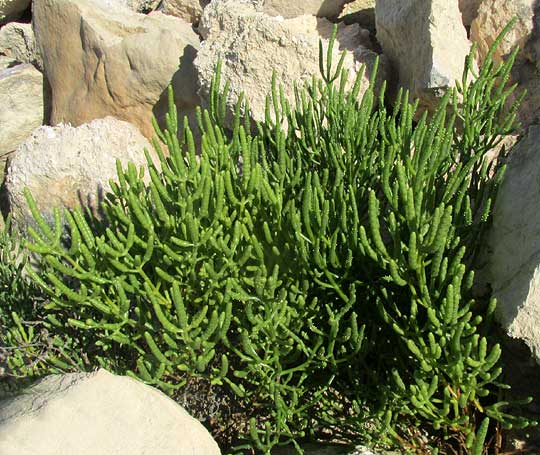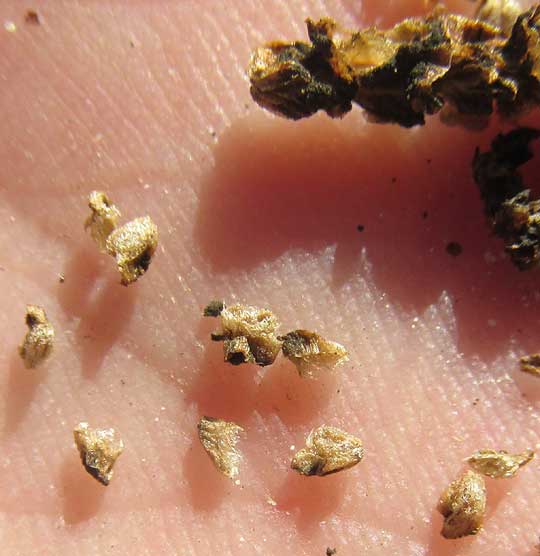Excerpts from Jim Conrad's
Naturalist Newsletter
from the June 14, 2015 Newsletter issued from Río Lagartos, on the Yucatan Peninsula's northern coast (~N21.60°, ~W88.16°), Yucatán state, MÉXICO
SALICORNIAS FLOWERING
Even the Salicornias are flowering, a Salicornia being a weird looking, much branched, succulent, salt loving (halophytic) plant commonly found here at the edges of salt marshes and sometimes at the edges of mangroves, as shown below, among some rocks piled at the mangrove's edge:

Sometimes Salicornias are known as Saltworts, Glassworts or Pickleweeds, but travelers I meet nowadays seem to be calling them Salicornias so that's what we'll use. They're SALICORNIA BIGELOVII, native to coastal areas of the eastern and southern US and southern California south along both of Mexico's coasts, and Belize.
Salicornia's flowers don't work hard to catch your eye. For example, below, take a look at some stems terminated by spikes of flowers:

In that picture several stems end in green, cylindrical, spike-type flowering heads, or inflorescences. One inflorescence has a few yellowish, sand-grain sized items attached. A close-up of some of those is shown below:

Up close it's clear that these are the male stamens poking from the stem. If you snap an inflorescence in two, inside you sometimes find immature anthers embedded in succulent flesh prior to their emergence, as shown below:

Salicornia's succulent inflorescences are segmented. When we read that in the genus Salicornia each segment consists of two 3-flowered groupings embedded in fleshy tissue of the segment above it, and that each of those six flowers per segment normally bears one or two stamens and an ovary with two styles, you wonder where all those parts are. Cutting the fleshy inflorescence lengthwise, or longitudinally, doesn't show much more, just an occasional anther preparing to emerge into the outer world. Pictures on the Internet show inflorescences with stigmas emerging but I can't find plants with stigmas, and will continue looking.
Some of our plants bear old inflorescences, shown below:

In that picture the center spikes bear mature fruits from which seeds can be shaken, shown below:

Those seeds look irregularly formed but if you know that Salicornias are members of the same family as Spinach plants, the Chenopodiaceae (newly lumped into the Amaranth Family), and you remember what Spinach seeds look like when you sow them in a garden, the seeds' shapes aren't surprising. Despite the seeds' tiny size, they're rich in oils. Experimental trials in the US have been made to harvest them on a large scale as a commercial source of vegetable oil. As oils go, Salicornia seed-oil has a high percentage of protein (35%), is highly polyunsaturated, exhibits a pleasant nut-like flavor, and has texture like olive oil, so you can see why there would be interest in it.
Salicornia bigelovii is a tetraploid, meaning that it has four times the chromosome number of the parent species from which it arose. One way tetraploid species can arise spontaneously in Nature is when during the process of meiosis sex germs are produced in which the chromosomes have failed to be reduced by half, as they should have been. This results in pollen grains or ovules having double the number of chromosomes than normal. When such "diploid" sex germs meet they produce tetraploid offspring of an entirely new species. You might enjoy reviewing Wikipedia's page describing this phenomenon.
Most tetraploid species display novel variations relative to their parental species, which might explain this species' surprisingly fleshy body. The body is so fleshy and salty tasting that I like to nibble on it as I walk the marshes, though I know that in large amounts its saponins can be poisonous.